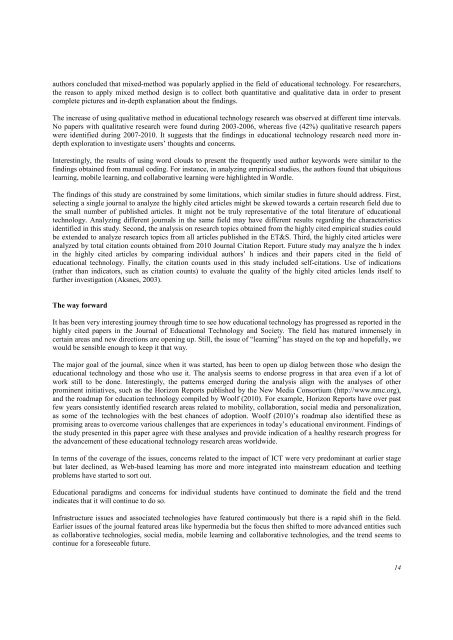Download Complete Issue in PDF - Educational Technology & Society
Download Complete Issue in PDF - Educational Technology & Society
Download Complete Issue in PDF - Educational Technology & Society
Create successful ePaper yourself
Turn your PDF publications into a flip-book with our unique Google optimized e-Paper software.
authors concluded that mixed-method was popularly applied <strong>in</strong> the field of educational technology. For researchers,<br />
the reason to apply mixed method design is to collect both quantitative and qualitative data <strong>in</strong> order to present<br />
complete pictures and <strong>in</strong>-depth explanation about the f<strong>in</strong>d<strong>in</strong>gs.<br />
The <strong>in</strong>crease of us<strong>in</strong>g qualitative method <strong>in</strong> educational technology research was observed at different time <strong>in</strong>tervals.<br />
No papers with qualitative research were found dur<strong>in</strong>g 2003-2006, whereas five (42%) qualitative research papers<br />
were identified dur<strong>in</strong>g 2007-2010. It suggests that the f<strong>in</strong>d<strong>in</strong>gs <strong>in</strong> educational technology research need more <strong>in</strong>depth<br />
exploration to <strong>in</strong>vestigate users’ thoughts and concerns.<br />
Interest<strong>in</strong>gly, the results of us<strong>in</strong>g word clouds to present the frequently used author keywords were similar to the<br />
f<strong>in</strong>d<strong>in</strong>gs obta<strong>in</strong>ed from manual cod<strong>in</strong>g. For <strong>in</strong>stance, <strong>in</strong> analyz<strong>in</strong>g empirical studies, the authors found that ubiquitous<br />
learn<strong>in</strong>g, mobile learn<strong>in</strong>g, and collaborative learn<strong>in</strong>g were highlighted <strong>in</strong> Wordle.<br />
The f<strong>in</strong>d<strong>in</strong>gs of this study are constra<strong>in</strong>ed by some limitations, which similar studies <strong>in</strong> future should address. First,<br />
select<strong>in</strong>g a s<strong>in</strong>gle journal to analyze the highly cited articles might be skewed towards a certa<strong>in</strong> research field due to<br />
the small number of published articles. It might not be truly representative of the total literature of educational<br />
technology. Analyz<strong>in</strong>g different journals <strong>in</strong> the same field may have different results regard<strong>in</strong>g the characteristics<br />
identified <strong>in</strong> this study. Second, the analysis on research topics obta<strong>in</strong>ed from the highly cited empirical studies could<br />
be extended to analyze research topics from all articles published <strong>in</strong> the ET&S. Third, the highly cited articles were<br />
analyzed by total citation counts obta<strong>in</strong>ed from 2010 Journal Citation Report. Future study may analyze the h <strong>in</strong>dex<br />
<strong>in</strong> the highly cited articles by compar<strong>in</strong>g <strong>in</strong>dividual authors’ h <strong>in</strong>dices and their papers cited <strong>in</strong> the field of<br />
educational technology. F<strong>in</strong>ally, the citation counts used <strong>in</strong> this study <strong>in</strong>cluded self-citations. Use of <strong>in</strong>dications<br />
(rather than <strong>in</strong>dicators, such as citation counts) to evaluate the quality of the highly cited articles lends itself to<br />
further <strong>in</strong>vestigation (Aksnes, 2003).<br />
The way forward<br />
It has been very <strong>in</strong>terest<strong>in</strong>g journey through time to see how educational technology has progressed as reported <strong>in</strong> the<br />
highly cited papers <strong>in</strong> the Journal of <strong>Educational</strong> <strong>Technology</strong> and <strong>Society</strong>. The field has matured immensely <strong>in</strong><br />
certa<strong>in</strong> areas and new directions are open<strong>in</strong>g up. Still, the issue of “learn<strong>in</strong>g” has stayed on the top and hopefully, we<br />
would be sensible enough to keep it that way.<br />
The major goal of the journal, s<strong>in</strong>ce when it was started, has been to open up dialog between those who design the<br />
educational technology and those who use it. The analysis seems to endorse progress <strong>in</strong> that area even if a lot of<br />
work still to be done. Interest<strong>in</strong>gly, the patterns emerged dur<strong>in</strong>g the analysis align with the analyses of other<br />
prom<strong>in</strong>ent <strong>in</strong>itiatives, such as the Horizon Reports published by the New Media Consortium (http://www.nmc.org),<br />
and the roadmap for education technology compiled by Woolf (2010). For example, Horizon Reports have over past<br />
few years consistently identified research areas related to mobility, collaboration, social media and personalization,<br />
as some of the technologies with the best chances of adoption. Woolf (2010)’s roadmap also identified these as<br />
promis<strong>in</strong>g areas to overcome various challenges that are experiences <strong>in</strong> today’s educational environment. F<strong>in</strong>d<strong>in</strong>gs of<br />
the study presented <strong>in</strong> this paper agree with these analyses and provide <strong>in</strong>dication of a healthy research progress for<br />
the advancement of these educational technology research areas worldwide.<br />
In terms of the coverage of the issues, concerns related to the impact of ICT were very predom<strong>in</strong>ant at earlier stage<br />
but later decl<strong>in</strong>ed, as Web-based learn<strong>in</strong>g has more and more <strong>in</strong>tegrated <strong>in</strong>to ma<strong>in</strong>stream education and teeth<strong>in</strong>g<br />
problems have started to sort out.<br />
<strong>Educational</strong> paradigms and concerns for <strong>in</strong>dividual students have cont<strong>in</strong>ued to dom<strong>in</strong>ate the field and the trend<br />
<strong>in</strong>dicates that it will cont<strong>in</strong>ue to do so.<br />
Infrastructure issues and associated technologies have featured cont<strong>in</strong>uously but there is a rapid shift <strong>in</strong> the field.<br />
Earlier issues of the journal featured areas like hypermedia but the focus then shifted to more advanced entities such<br />
as collaborative technologies, social media, mobile learn<strong>in</strong>g and collaborative technologies, and the trend seems to<br />
cont<strong>in</strong>ue for a foreseeable future.<br />
14

















